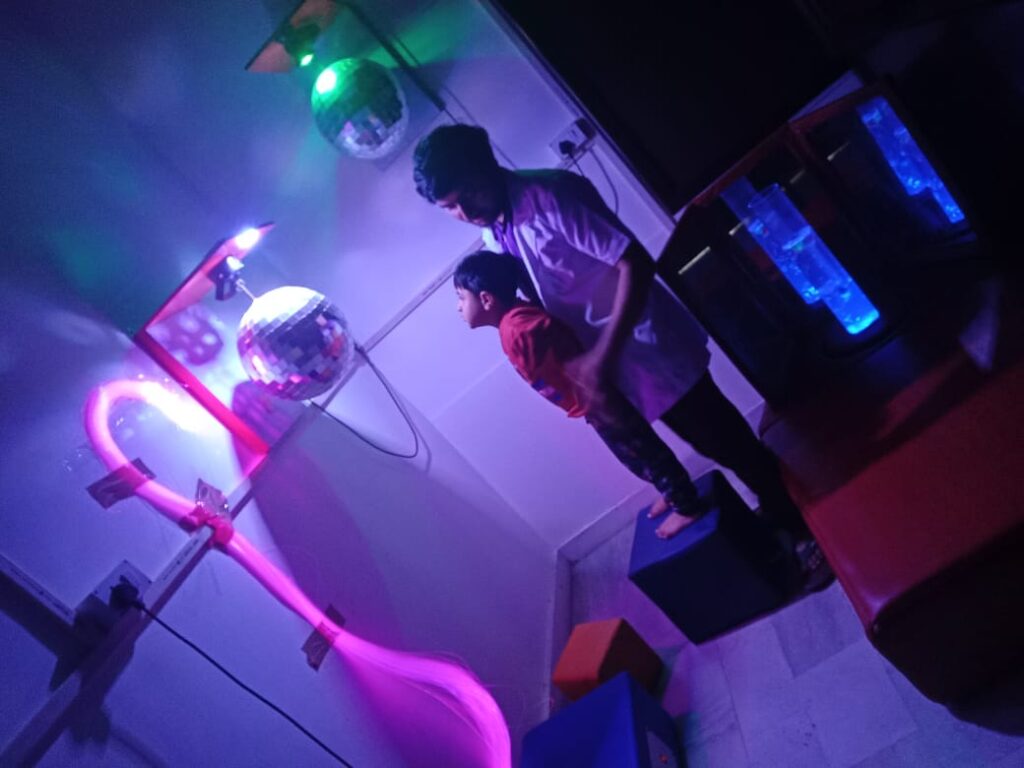
Sensory Integration Therapy
Developed by occupational therapist A. Jean Ayres in the 1970s, SIT is a therapeutic approach that helps children with sensory processing difficulties (SPD). It’s based on the idea that the brain needs to be able to properly organize and interpret sensory information from the seven senses: sight, sound, touch, taste, smell, body awareness, balance and movement.
When these senses are not integrated well, it can lead to a variety of challenges. This therapy aims to address these challenges by providing controlled sensory experiences in a structured and therapeutic environment. The therapy sessions are designed to help individuals gradually adapt to sensory input, improve sensory processing skills, and develop more adaptive responses to sensory stimuli.
1.Comprehensive Assessment: The therapy begins with a thorough sensory assessment to identify the individual’s sensory sensitivities and processing difficulties.
2.Goal Setting: Collaboratively setting clear and achievable goals with the individual, caregivers, or parents to address specific sensory challenges.
3.Sensory Diet: Developing a sensory diet or schedule that includes sensory activities designed to provide the right level and type of sensory input. This may include activities like swinging, brushing, tactile experiences, and deep pressure exercises.
4.Sensory Integration Room: In some cases, individuals may have access to a sensory integration room equipped with sensory equipment like swings, weighted blankets, fiber optic lighting, and soundscapes to facilitate sensory experiences.
5.Sensory Stimulation Activities: Encouraging participation in various sensory-stimulating activities tailored to the individual’s needs and sensitivities.
6.Adaptive Techniques: Teaching the individual techniques to manage sensory overload and self-regulate their sensory experiences.
7.Environmental Modifications: Suggesting changes to the home or classroom environment to reduce sensory distractions or create sensory-friendly spaces.
8.Regular Progress Monitoring: Continuously assessing progress and adjusting the sensory diet and activities to meet changing sensory needs and goals.
9.Emotional Support: Providing emotional support and coping strategies to individuals and their families who may be dealing with the challenges of sensory processing difficulties.
When these senses are not integrated well, it can lead to a variety of challenges. This therapy aims to address these challenges by providing controlled sensory experiences in a structured and therapeutic environment. The therapy sessions are designed to help individuals gradually adapt to sensory input, improve sensory processing skills, and develop more adaptive responses to sensory stimuli.
- Comprehensive Assessment: The therapy begins with a thorough sensory assessment to identify the individual’s sensory sensitivities and processing difficulties.
- Goal Setting: Collaboratively setting clear and achievable goals with the individual, caregivers, or parents to address specific sensory challenges.
- Sensory Diet: Developing a sensory diet or schedule that includes sensory activities designed to provide the right level and type of sensory input. This may include activities like swinging, brushing, tactile experiences, and deep pressure exercises.
- Sensory Integration Room: In some cases, individuals may have access to a sensory integration room equipped with sensory equipment like swings, weighted blankets, fiber optic lighting, and soundscapes to facilitate sensory experiences.
- Sensory Stimulation Activities: Encouraging participation in various sensory-stimulating activities tailored to the individual’s needs and sensitivities.
- Adaptive Techniques: Teaching the individual techniques to manage sensory overload and self-regulate their sensory experiences.
- Environmental Modifications: Suggesting changes to the home or classroom environment to reduce sensory distractions or create sensory-friendly spaces.
- Regular Progress Monitoring: Continuously assessing progress and adjusting the sensory diet and activities to meet changing sensory needs and goals.
- Emotional Support: Providing emotional support and coping strategies to individuals and their families who may be dealing with the challenges of sensory processing difficulties.
The ultimate goal of Sensory Integration Therapy is to help individuals with sensory processing disorders or sensory sensitivities become more comfortable and functional in their daily lives. By improving sensory modulation and self-regulation, individuals can better manage their responses to sensory input, reduce anxiety and sensory-related challenges, and enhance their overall well-being.





